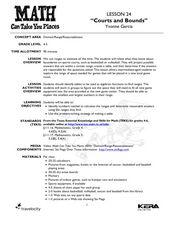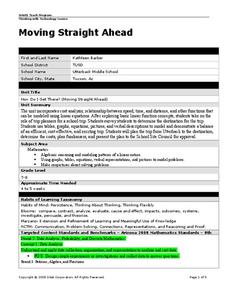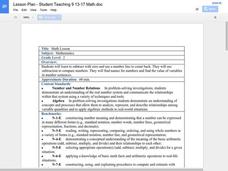Curated OER
Figuring Out Equations With Figurines
Students inspect solving equations with one variable. Through the use of a scale balance, they examine the importance of equality in an equation. By playing a balance game with figurines and a scale, students discover methods of...
Curated OER
Giggle, Giggle, Quack Pizza Fractions
Students explore the concept of multiplication by using pizza. They read an article discussing how math is used everyday. They try to determine how many pizzas they would need to feed the class.
Curated OER
Linear Functions
Fifth graders investigate the concept of a function in relationship to how it is used. The concept is essential for the future study of Algebra. They apply the use of patterns with its relationship to functions.
Curated OER
Addition With Integers
Eighth graders investigate the concept of combing integers using addition. They begin to comprehend the connection of addition and subtraction. Students also review the concept of positive and negative numbers.
Curated OER
Courts and Bounds
Learners relate what they know about boundaries on sports courts to explore range of space. In this domain and range lesson, students identify numbers needed to calculate ranges and use the problem solving strategy of making a table.
Curated OER
Operations of Complex Numbers and Intro to DeMoivre's Theorem
Students solve problems with complex numbers. In this algebra instructional activity, students factor complex numbers and simplify equations using DeMoivre's Theorem. They add, subtract, multiply and divide using negative roots.
Curated OER
Addition Properties
Student study addition properties. In this addition properties lesson plan, young scholars use multiple methods to solve various types of problems. Students illustrate and describe in various ways the Commutative Property of...
Curated OER
Intro To Probability
Students investigate the concepts related to the practice of using probability. They review the use of mean, median, and mode within the context of previous instruction. Students predict outcomes and calculate them in small groups. The...
Curated OER
The Coordinate Plane
Students engage in a lesson that is about the concept of graphing using the coordinate plane. They view a PowerPoint presentation and practice solving different problems. Students discuss vocabulary words with the help of the PowerPoint.
Curated OER
Divide Polynomials
In this division of polynomials worksheet, students complete a set of 10 problems, answers are included on page 2; a reference web site is given for additional activities.
Curated OER
Quadratic and Linear Functions
In this Algebra II learning exercise, 11th graders review and apply the basic concepts for solving linear and quadratic equation. The one page learning exercise contains twelve problems. Solutions are not provided.
Curated OER
Moving Straight Ahead
Students analyze the relationship between speed, time and distance. In this math lesson, students plan a school trip. Students determine the efficiency and cost effectiveness of a trip.
Curated OER
Using Polynomials To Find Perimeter
Fifth graders engage in the solving of a real life application problem using the concept of calculating perimeter. They apply the operations of calculating with the polynomials for finding the perimeter of triangles,quadrilaterals, and...
Curated OER
Two-Step Equations
Young scholars explore the concept of solving two-step equations. In this solving two-step equations lesson, students watch a short video about solving equations. Young scholars view a PowerPoint presentation about solving two-step...
National Security Agency
A Balancing Act: Solving Multi-Step Equations
Wow! Put on that thinking cap and solve multi-step equations. To solve equations, learners review the use of the distributive property and combining like terms. This three-day lesson comes with about 20 pages of worksheets, warm-ups,...
Curated OER
Properties of Fractals
Students build a working definition of a regular fractal, they measure the concepts of dimensions and scale, they explore the concept of a logarithm and they attempt to solve simple exponential equations for the exponent both by trial...
Curated OER
Properties of Fractals
Students build a working definition of regular fractal, look carefully at the concepts of dimension and scale, and are introduced to logarithms. They solve simple exponential equations for the exponent both by trial and error and using...
Curated OER
A Pocketful of Change
Students study the meaning, symbolism, and value of U.S. coins,
especially the quarter. They conduct a survey of coins in students'
possession, graphing the results to show frequency distribution and drawing
inferences about the U.S....
Curated OER
The Mandelbrot Set
Learners explore the Mandelbrot Set. They are introduced to the concept of a complex number and function in order to motivate the discussion of Julia and Mandelbrot sets. Students investigate fractals and how they are built.
Curated OER
Introduction to Economics
Students develop the concept of supply and demand. In this economics lesson, students listen to a lecture and take notes on supply and demand. Students create a coherent set of notes about supply and demand.
Curated OER
Perimeters, Patterns, and Conjectures
Young scholars discover patterns and write conjectures relating to perimeters and polygons. Working in cooperative learning groups, they use manipulatives and graphic organizers to solve problems then answer a series of questions in...
Curated OER
Number Line Math
Second graders use a number line to practice subtraction. For this subtraction lesson, 2nd graders use a number line to count backwards. Students participate in mad math activities and solve problems.
Curated OER
Figure This!
Second graders explore the concept of inequalities. They use the mathematical symbols =, <, > to show relationships among numbers. Students devise and use problem solving strategies to explore the situation.
Curated OER
Prime and Composite Numbers with use of manipulatives (Elementary, Mathematics)
Students learn what prime and composite numbers are. They learn how to identify them by working in a group and demonstrating an understanding of one work problem with 100% accuracy using the manipulatives provided.























